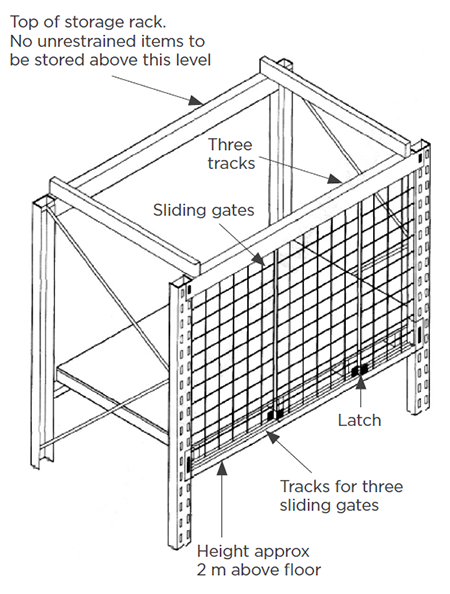Most regions of New Zealand are prone to earthquakes, and bulk storage facilities and retail stores must consider building restraint for contents as part of their safety management programmes.
Most regions of New Zealand are prone to earthquakes, and bulk storage facilities and retail stores must consider building restraint for contents as part of their safety management programmes.
Restraint of building contents
The standard for Seismic restraint of building contents (NZS 4104) requires the restraint of of building contents in certain conditions. The standard provides considerable detail, and building owners and persons conducting a business or undertaking (PCBUs) should make themselves aware of its requirements.
Shelving and racking systems
- Shelving and racking systems should be designed and maintained so that that they can withstand the affects of an earthquake.
- Items stored above 1.2 metres high and weighing over 5kg must be restrained in order to prevent them from falling onto the ground or personnel working beneath.

The Seismic Restraint of Building Contents standard has a variety of options for restraint of goods. As an example it suggests that items stored on shelving systems in supermarkets above 1.8–2.0 metres should be enclosed with sliding gates.
WorkSafe New Zealand recommends that PCBUs should engage a consulting engineer to review their shelving systems’ verification and certification to ensure that they meet the requirements of NZS 4219 – Seismic performance of engineering systems in buildings, which contains the current state of knowledge on the topic.
The relevant design standards for shelving and racking systems are:
- NZS 1170.5 – Structural design actions – Earthquake actions – New Zealand
- NZS 3404.1 Steel structures
- The BRANZ Design Guide – Seismic Design of High Level Storage Racking Systems with Public Access.
Regular checks of shelving systems should be conducted to look for damage from forklifts or trolleys, missing bolts, bent steel supports or shelves, etc.
Palletised goods
In frequently-occupied areas (defined by NZS 4104), palletised goods should be restrained to prevent them from creeping and falling from the racking system.
The height of shrink-wrapped pallets should not exceed two times their base, in order to reduce any toppling effect. The shrink wrapping should extend around the base of the pallet so that the goods and the pallet form one unit.
Pallets should be in good condition – broken pallets should be removed from service.
Hazardous substances
Extra care needs to be taken when shelving hazardous substances. If incompatible hazardous substances fall from shelving in an earthquake and their packaging is breached, chain reactions such as the release of hazardous gases or sparks leading to a fire could occur.
In addition:
- keep extra supplies of hazardous substance stock in segregated areaskeep filled gas cylinders stored as close to the ground as possible, or securely enclosed in a cage or similar that allows air to circulate through.
Heavy items stored below two metres on open shelving
Certain supplies of stock, such as shrink- wrapped canned or bottled goods, are heavy enough to cause serious injuries or death if they fall off shelves onto workers or shoppers.
Heavy or solid items should not be stacked more than 1.2 m high without restraint to prevent causing injury during an earthquake. Heavy items must not be stored near frequently occupied areas or near doors/exits to prevent blockage during an earthquake.
Post-earthquake inspection
The BRANZ Design Guide contains advice for inspecting storage racking systems after an earthquake if racks have collapsed or have become seriously misaligned:
- the store should be immediately closed to the public
- an appropriately qualified person should carry out an assessment to ascertain ongoing safety of the damaged system before entry for rescue and clean-up
- personnel should not be allowed into the area without expert advice on the safety of damaged racks
- temporary shoring may be required to support damaged rack systems before it is safe to allow entry.
If an earthquake has caused stock to fall from shelves, even if there is no apparent rack damage, it is recommended that:
- the store should be immediately closed to the public
- the racking system should be thoroughly inspected
- stored items need to be checked for their stability.
References:
- BRANZ Design Guide - Seismic Design of High Level Storage Racking Systems with Public Access, available at www.branz.co.nz(external link)
- NZS 1170.5 Structural design actions –Earthquake actions – New Zealand
- NZS 4219 Seismic performance of engineering systems in buildings
- NZS 4104 Seismic restraint of building contents
- NZS 3404 Steel structures standard Part 1
Note: New Zealand and joint Australian- New Zealand standards are available for purchase at Standards New Zealand. Visit them at www.standards.co.nz(external link).
Footnotes
[1] Figure 1 sourced from NZS 4104 Seismic restraint of building contents.
Last updated